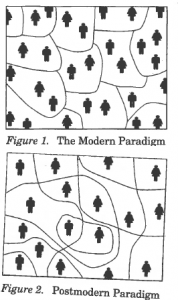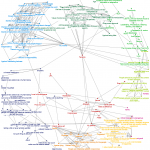Real ideological movements are under no one’s control. They shape-shift and amalgamate until it is both difficult and misleading to define them in terms of core principles. The debate about their meaning not only reflects authentic intellectual inquiry but also a series of power-plays. If you can make conservatism mean what you want it to mean, for example, then you can line up support from people who identify as conservatives.
Michael Freeden studies the patterns of ideas that form political ideologies, which he calls their “morphologies.” He notes, “Morphology is not always consciously designed. Even when design enters the picture, it is partial, fragmented, and undergirded by layers of cultural meaning that are pre-assimilated into rational thinking.”*
Still, we can learn from ideologies, and not only from the relatively transparent and organized arguments that their theorists set down on paper. Political movements reflect accumulated experience. Although some movements are beyond the pale, all reasonably mainstream political ideologies invoke clusters of central ideas that deserve consideration.
In an earlier post, I argued that the valuable, core, animating impulse of conservatism is resistance to human arrogance. Conservatism can take different forms depending on the form of arrogance that is assumed to be most dangerous. If it’s the arrogance of central state planners, laissez-faire looks attractive. If it’s the arrogance of godless human beings, religious authority may look better. If it’s the arrogance of faceless corporations, small human communities may seem safer. Although these are disparate enemies, they are all charged with the same fundamental sin: blindness to human cognitive and ethical limitations.
What, then of liberalism? Empirically, it is at least as various as conservatism is. It would be appropriate to apply the word “liberal” to a New Deal social democrat or to a minimal-government libertarian, although they represent opposite poles in the US political debate.
Nevertheless, as with conservatism, we can undertake an appreciative reconstruction of liberalism as an ethical orientation. Its valuable, core, animating impulse is a high regard for the individual’s inner life–her ideas, passions, and commitments–and their expression in her personal behavior. That attitude can recommend a range of institutions, from a hyper-minimal state (to protect the individual against tyranny) to a strong social welfare state (to enable her to develop her individuality). That is why liberals span the US political spectrum. Yet not everyone is a liberal. If you see a community or a nation as having intrinsic value, you are (at least in that respect) distant from liberalism. If you see equality as an end, rather than as a potential means to individuals’ development, you diverge from liberalism. If you are confident that one or a few ways of life embody the human good and should be encouraged or required, you are not fully liberal.
Although liberalism permits a wide range of political institutions, it has a fairly consistent cultural agenda. It favors the cultivation and appreciation of complex and diverse personalities. It is tolerant of the contemplative (rather than the active) life, of irony and ambiguity, of personal expressions against the crowd. Its most characteristic cultural form is the sensitive depiction of individuals in intimate relationships without the overlay of a strong authorial voice–as in the nineteenth-century novel or the Impressionist portrait. “Negative capability” (the ability not to take a position when describing the world) is the aesthetic analog of the liberal’s political principle of tolerance.
The poet Mark Strand gave a characteristic liberal’s response to the question, “What is your view of the function of poetry in today’s society?”:
Poetry delivers an inner life that is articulated to the reader. People have inner lives, but they are poorly expressed and rarely known. They have no language by which to bring it out into the open. … Poetry helps us imagine what it’s like to be human. I wish more politicians and heads of state would begin to imagine what it’s like to be human. They’ve forgotten, and it leads to bad things. If you can’t empathize, it’s hard to be decent; it’s hard to know what the other guy’s feeling. They talk from such a distance that they don’t see differences; they don’t see the little things that make up a life. They see numbers; they see generalities. They deal in sound bytes and vacuous speeches; when you read them again, they don’t mean anything.
These may be clichés (and Strand’s generalizations about politicians are just as empty as their alleged generalization about citizens). But in a poem like “The Way it Is,” Strand shows what he means. The narrator is beset by his jingoistic, gun-toting neighbor (“wearing the sleek / mask of a hawk with a large beak”) and by horsemen “riding around [the people], telling them why / they should die.” In other words, he fears the individual with no inner life and the faceless state. “I crouch / under the kitchen table, telling myself / I am a dog, who would kill a dog?” This is the liberal’s nightmare, but the poem is an act of freedom as self-expression.
Along similar lines, Lionel Trilling endorsed impersonal rules and institutions that enhanced freedom and happiness, yet he wished to “recall liberalism to its first essential imagination of variousness and possibility, which implies the awareness of complexity and difficulty.”** For Trilling, sensitive literary criticism was a characteristic liberal act because it involved the recovery of another individual’s thought.
On this definition, you can be a liberal and also a conservative, a socialist, and/or a majoritarian; those categories are not mutually exclusive. But liberalism points in certain directions and warns against certain dangers often forgotten in other ideologies.
—
*Michael Freeden, “The Morphological Analysis of Ideology,” in Freeden, Lyman Tower Sargent, and Marc Stears (eds.), The Oxford Handbook of Political Ideologies (Oxford, 2013), pp. 115-137 (quoting p. 122.)
**Trilling, The Liberal Imagination: Essays on Literature and Society (1950) (New York: New York Review of Books, 2008), p. xxi.

